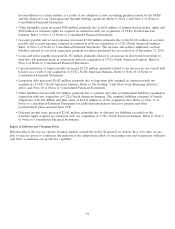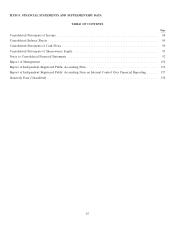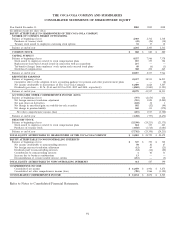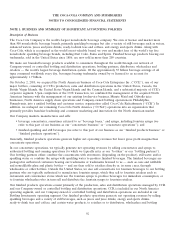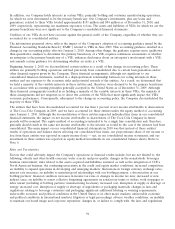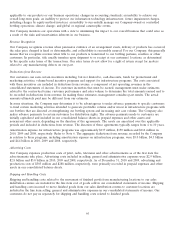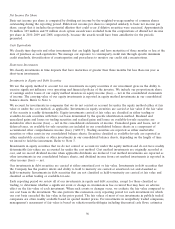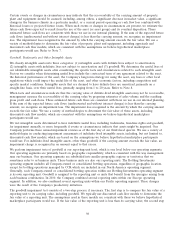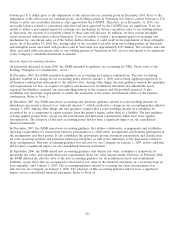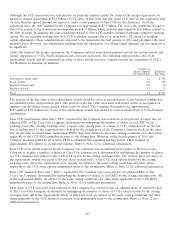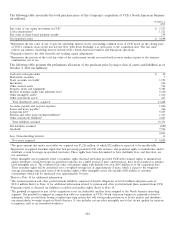Coca Cola 2010 Annual Report Download - page 96
Download and view the complete annual report
Please find page 96 of the 2010 Coca Cola annual report below. You can navigate through the pages in the report by either clicking on the pages listed below, or by using the keyword search tool below to find specific information within the annual report.In addition, our Company holds interests in certain VIEs, primarily bottling and container manufacturing operations,
for which we were determined to be the primary beneficiary. Our Company’s investments, plus any loans and
guarantees, related to these VIEs totaled approximately $191 million and $84 million as of December 31, 2010, and
2009, respectively, representing our maximum exposures to loss. The assets and liabilities of VIEs for which we are the
primary beneficiary were not significant to the Company’s consolidated financial statements.
Creditors of our VIEs do not have recourse against the general credit of the Company, regardless of whether they are
accounted for as consolidated entities.
The information presented above reflects the impact of the Company’s adoption of accounting guidance issued by the
Financial Accounting Standards Board (‘‘FASB’’) related to VIEs in June 2009. This accounting guidance resulted in a
change in our accounting policy effective January 1, 2010. Among other things, the guidance requires more qualitative
than quantitative analyses to determine the primary beneficiary of a VIE, requires continuous assessments of whether
an enterprise is the primary beneficiary of a VIE, enhances disclosures about an enterprise’s involvement with a VIE,
and amends certain guidance for determining whether an entity is a VIE.
Beginning January 1, 2010, we deconsolidated certain entities as a result of this change in accounting policy. These
entities are primarily bottling operations and had previously been consolidated due to certain loan guarantees and/or
other financial support given by the Company. These financial arrangements, although not significant to our
consolidated financial statements, resulted in a disproportionate relationship between our voting interests in these
entities and our exposure to the economic risks and potential rewards of the entities. As a result, we determined that
we held a majority of the variable interests in these entities and, therefore, were deemed to be the primary beneficiary
in accordance with accounting principles generally accepted in the United States as of December 31, 2009. Although
these financial arrangements resulted in us holding a majority of the variable interests in these VIEs, the majority of
these arrangements did not empower us to direct the activities of the VIEs that most significantly impact the VIEs’
economic performance. Consequently, subsequent to the change in accounting policy, the Company deconsolidated the
majority of these VIEs.
The entities that have been deconsolidated accounted for less than 1 percent of net income attributable to shareowners
of The Coca-Cola Company in 2009, and we have accounted for these entities under the equity method of accounting
since January 1, 2010. Although the deconsolidation of these entities impacted individual line items in our consolidated
financial statements, the impact on net income attributable to shareowners of The Coca-Cola Company in future
periods will be nominal. The equity method of accounting is intended to be a single line consolidation and, therefore,
generally should result in the same net income attributable to the investor as would be the case if the investee had been
consolidated. The main impact on our consolidated financial statements in 2010 was that instead of these entities’
results of operations and balance sheets affecting our consolidated line items, our proportionate share of net income or
loss from these entities was reported in equity income (loss) — net, in our consolidated income statements, and our
investment in these entities was reported as equity method investments in our consolidated balance sheets. Refer to
Note 6.
Risks and Uncertainties
Factors that could adversely impact the Company’s operations or financial results include, but are not limited to, the
following: obesity and other health concerns; water scarcity and poor quality; changes in the nonalcoholic beverages
business environment; risks related to the assets acquired and liabilities assumed, as well as the integration of CCE’s
North American business; the continuing uncertainty in the credit and equity market conditions; increased competition;
an inability to expand operations in developing and emerging markets; fluctuations in foreign currency exchange rates;
interest rate increases; an inability to maintain good relationships with our bottling partners; a deterioration in our
bottling partners’ financial condition; increases in income tax rates or changes in income tax laws; increased or new
indirect taxes; an inability to renew collective bargaining agreements on satisfactory terms or strikes, work stoppages or
labor unrest (including at bottling partners’ manufacturing locations); increased cost, disruption of supply or shortage of
energy; increased cost, disruption of supply or shortage of ingredients or packaging materials; changes in laws and
regulations relating to beverage containers and packaging; significant additional labeling or warning requirements;
unfavorable economic and political conditions in the United States or in other major markets; unfavorable economic
and political conditions in international markets; litigation or legal proceedings; adverse weather conditions; an inability
to maintain our brand image and corporate reputation; changes in, or failure to comply with, the laws and regulations
94


